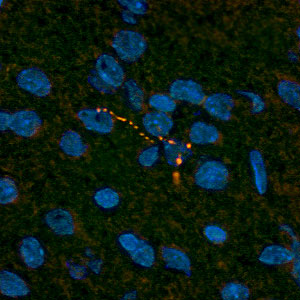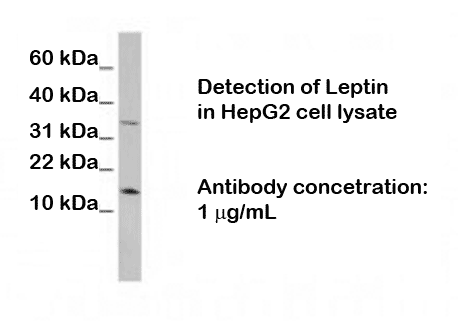Antibodies
| Rabbit polyclonal antibody to Leptin | |
|---|---|
 Immunohistochemical detection of Leptin in mouse hypothalamus. Mouse brain was fixed with 4% formaldehyde and cut into 10 μm thick cryostat sections. Tissue was incubated with rabbit polyclonal antibody to Leptin at 15 μg/mL overnight at 4°C followed by incubation with Donkey anti-rabbit Rhodamine Red conjugated secondary antibodies at 1:200. Cell nuclei were counterstained with DAPI (blue) Immunohistochemical detection of Leptin in mouse hypothalamus. Mouse brain was fixed with 4% formaldehyde and cut into 10 μm thick cryostat sections. Tissue was incubated with rabbit polyclonal antibody to Leptin at 15 μg/mL overnight at 4°C followed by incubation with Donkey anti-rabbit Rhodamine Red conjugated secondary antibodies at 1:200. Cell nuclei were counterstained with DAPI (blue) |
 |
| Formulation | Lyophilized powder |
| Purification | Affinity purified |
| Host Species | Rabbit |
| Unit Size: | 50 µg |
| Immunogen | Synthetic peptide |
| Sequence: | LHVLAFSKSCHLPWASGLETLDSLGGVLEASGYSTEVVALSRLQGSLQDM |
| Alternative Names | Obese protein, obesity factor |
| Accession Number: | P41159 |
| Gene Symbol | LEP |
| Accession URL: | http://www.uniprot.org/uniprot/P41159 |
| Function: Leptin is a protein that is secreted by white adipocytes, and which plays a major role in the regulation of body weight. This protein, which acts through the leptin receptor, functions as part of a signaling pathway that can inhibit food intake and/or regulate energy expenditure to maintain constancy of the adipose mass. This protein also has several endocrine functions, and is involved in the regulation of immune and inflammatory responses, hematopoiesis, angiogenesis and wound healing. Mutations in this gene and/or its regulatory regions cause severe obesity, and morbid obesity with hypogonadism. This gene has also been linked to type 2 diabetes mellitus development.This gene encodes a protein that is secreted by white adipocytes, and which plays a major role in the regulation of body weight. This protein, which acts through the leptin receptor, functions as part of a signaling pathway that can inhibit food intake and/or regulate energy expenditure to maintain constancy of the adipose mass. This protein also has several endocrine functions, and is involved in the regulation of immune and inflammatory responses, hematopoiesis, angiogenesis and wound healing. Mutations in this gene and/or its regulatory regions cause severe obesity, and morbid obesity with hypogonadism. |
|
| Applications: | Immunohistochemistry (IHC), Immunocytochemistry (ICC), Western Blotting (WB). |
| Working Dilution for Immunofluorescence (ICC): | 5 – 15 µg/mL |
| Working Dilution for Immunohistochemistry (IHC): | 5 – 10 µg/mL |
| Working Dilution for Western Blottin (WB): | 1 µg/mL |
| IHC Positive control: | Brain (hipothalamus), adipocytes. |
| Specificity: | Confirmed by WB. |
| Cross-reactivity: | Human; mouse; rat |
| Reconstitution: | Reconstitute in 0.05 mL of PBS (pH 7.4) to achieve an antibody concentration of 1000 µg/mL. Centrifuge to remove any insoluble material. |
| Storage / Stability: | At least 12 months after purchase at 2 - 4°C. After reconstitution, aliquot and store at -20°C for a higher stability and at 4°C with an appropriate antibacterial agent. Avoid freeze-thaw cycles. |
References
|
|
